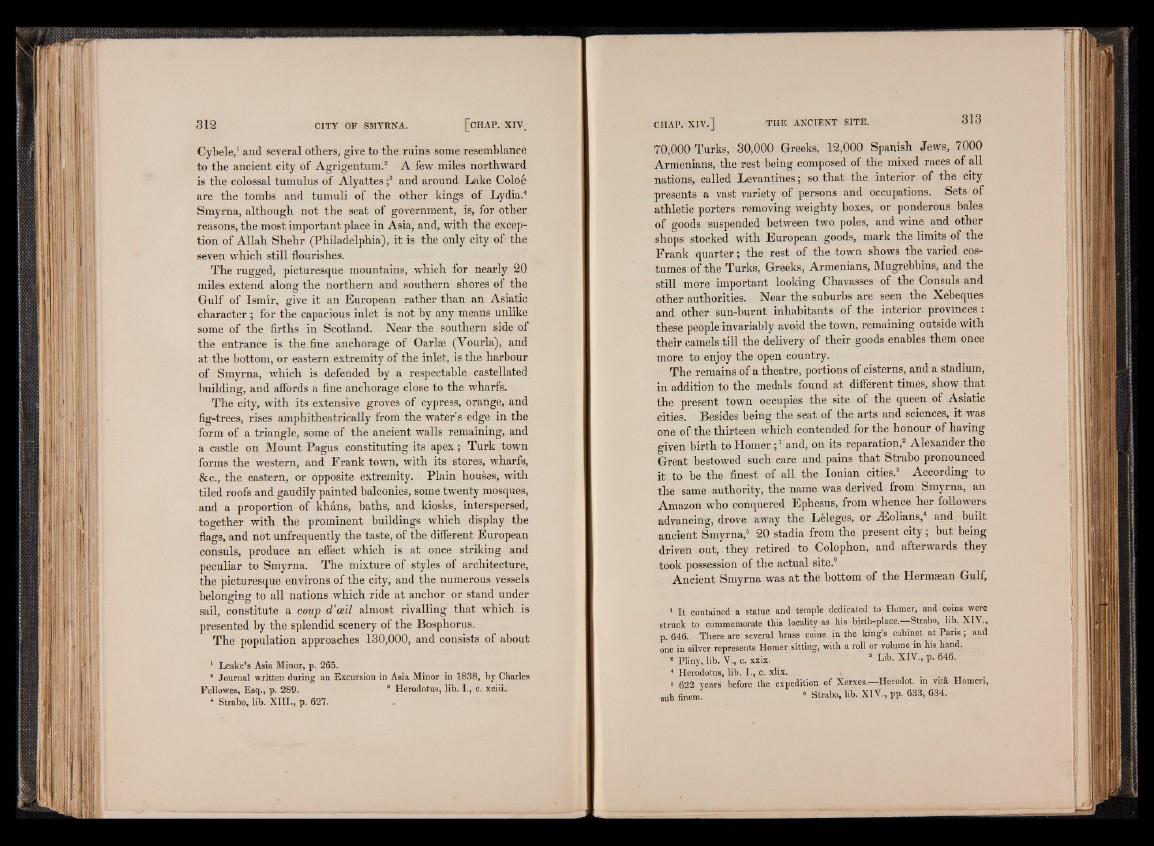
Cybele,1 and several others, give to the ruins some resemblance
to the ancient city of Agrigentum.2 A few miles northward
is the colossal tumulus of Alyattes ;3 and around Lake Colog
are the tombs and tumuli of the other kings of Lydia.4
Smyrna, although not the seat of government, is, for other
reasons, the most important place in Asia, and, with the exception
of Allah Shehr (Philadelphia), it is the only city of the
seven which still flourishes.
The rugged, picturesque mountains, which for nearly 20.
miles extend along the northern and southern shores of the
Gulf of Ismir, give it an European rather than an Asiatic
character; for the capacious inlet is not by any means unlike
some of the firths in Scotland. Near the southern side of
the entrance is the fine anchorage of Oarlse (Vourla), and
at the bottom, or eastern extremity of the inlet, is the harbour
of Smyrna, which is defended by a respectable castellated
building, and aflords a fine anchorage close to the wharfs.
The city, with its extensive groves of cypress, orange, and
fig-trees, rises amphitheatrically from the water’s edge in the
form of a triangle, some of the ancient walls remaining, and
a castle on Mount Pagus constituting its apex; Turk town
forms the western, and Frank town, with its stores, wharfs,
&c., the eastern, or opposite extremity. Plain houses, with
tiled roofs and gaudily painted balconies, some twenty mosques,
and a proportion of khans, baths, and kiosks, interspersed,
together with the prominent buildings which display the
flags, and not unfrequently the taste, of the different European
consuls, produce an effect which is at once striking and
peculiar to Smyrna. The mixture of styles of architecture,
the picturesque environs of the city, and the numerous vessels
belonging to all nations which ride at anchor or stand under
sail, constitute a coup d ’ceil almost rivalling that which is
presented by the splendid scenery of the Bosphorus.
The population approaches 130,000, and consists of about
1 Leake’s Asia Minor, p. 265.
! Journal written during an Excursion in Asia Minor in 1838, by Charles
Fellowes, Esq., p. 289. “ Herodotus, lib. I., c. xciii.
* Strabo, lib. XIII., p. 621.
70,000 Turks, 30,000 Greeks, 12,000 Spanish Jews, 7000
Armenians, the rest being composed of the mixed races of all
nations, called Levantines; so that the interior of the city
presents a vast variety of persons and occupations. Sets of
athletic porters removing weighty boxes, or ponderous bales
of goods suspended between two poles, and wine and other
shops stocked with European goods, mark the limits of the
Frank quarter; the rest of the town shows the varied costumes
of the Turks, Greeks, Armenians, Mugrebbins, and the
still more important looking Chavasses of the Consuls and
other authorities. Near the suburbs are seen the Xebeques
and other sun-burnt inhabitants of the interior provinces :
these people invariably avoid the town, remaining outside with
their camels till the delivery of their goods enables them once
more to enjoy the open country.
The remains of a theatre, portions of cisterns, and a stadium,
in addition to the medals found at different times, show that
the present town occupies the site of the queen of Asiatic
cities. Besides being the seat of the arts and sciences, it was
one of the thirteen which contended for the honour of having
given birth to Homer;1 and, on its reparation,2 Alexander the
Great bestowed such care and pains that Strabo pronounced
it to be the finest of all the Ionian cities.3 According to
the same authority, the name was derived from Smyrna, an
Amazon who conquered Ephesus, from whence her followers
advancing, drove away the Leleges, or iEolians,4 and built
ancient Smyrna,5 20 stadia from the present city; but being
driven out, they retired to Colophon, and afterwards they
took possession of the actual site.6
Ancient Smyrna was at the bottom of the Hermsean Gulf)
1 It contained a statue and temple dedicated to Homer, and coins were
struck to commemorate this locality as his birth-place. Strabo, lib. XIV.,
p. 646. There are several brass coins in the king’s cabinet at Paris; and
one in silver represents Homer sitting, with a roll or volume in his hand.
* Pliny, lib. V., c. xxix. 8 Ldh XIV., p. 646.
4 Herodotus, lib. I., c. xlix. ■ A
5 622 years before the expedition of Xerxes.—Herodot. in vit& Homeri,
sub finem. 6 Strabo, lib. XIV., pp. 633, 634.